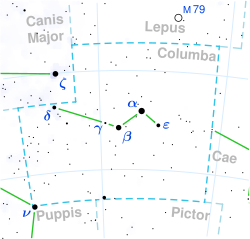Solitary star in the constellation Columba
HD 34266 , also known as HR 1721 is a solitary, yellow hued star located in the southern constellation Columba , the dove. It has an apparent magnitude of 5.73, making it faintly visible to the naked eye under ideal conditions. Based on Gaia DR3 parallax measurements, the object is located 539 light years away. It appears to be drifting away from the Solar System , having a heliocentric radial velocity of 13.2 km/s .
This is an evolved giant star that is currently on the red giant branch , fusing hydrogen in a shell around an inert helium core. It has a stellar classification of G8 III. HD 34266 is calculated to be 490 million years old, almost 10 times younger than the Sun . However, it already left the main sequence due to a mass of 3.42 M ☉ Sun's girth and now radiates 144 times the luminosity of the Sun from its photosphere at an effective temperature of 4,970 K . HD 34266 has a near solar metallicity and spins modestly with a projected rotational velocity of 2.3 km/s .
References
^ Vallenari, A.; et al. (Gaia collaboration) (2023). "Gaia Data Release 3. Summary of the content and survey properties" . Astronomy and Astrophysics . 674 : A1. arXiv :2208.00211 . Bibcode :2023A&A...674A...1G . doi :10.1051/0004-6361/202243940 . S2CID 244398875 .
Gaia DR3 record for this source at VizieR .
^ Høg, E.; Fabricius, C.; Makarov, V. V.; Urban, S.; Corbin, T.; Wycoff, G.; Bastian, U.; Schwekendiek, P.; Wicenec, A. (March 2000). "The Tycho-2 catalogue of the 2.5 million brightest stars". Astronomy and Astrophysics . 355 : L27 – L30. Bibcode :2000A&A...355L..27H . ISSN 0004-6361 .
^ Jones, M. I.; Jenkins, J. S.; Rojo, P.; Melo, C. H. F. (December 2011). "Study of the impact of the post-MS evolution of the host star on the orbits of close-in planets: I. Sample definition and physical properties⋆⋆⋆" . Astronomy & Astrophysics . 536 : A71. arXiv :1110.6459 . Bibcode :2011A&A...536A..71J . doi :10.1051/0004-6361/201117887 . ISSN 0004-6361 .
^ Houk, N. (1982). Michigan Catalogue of Two-dimensional Spectral Types for the HD stars. Volume III: Declinations −40° to −26° . Bibcode :1982mcts.book.....H .
Johnson, H. L.; Mitchell, R. I.; Iriarte, B.; Wisniewski, W. Z. (1 January 1966). "UBVRIJKL Photometry of the Bright Stars". Communications of the Lunar and Planetary Laboratory . 4 : 99–110. Bibcode :1966CoLPL...4...99J .
^ Gontcharov, G. A. (November 2006). "Pulkovo Compilation of Radial Velocities for 35 495 Hipparcos stars in a common system". Astronomy Letters . 32 (11): 759–771. arXiv :1606.08053 . Bibcode :2006AstL...32..759G . doi :10.1134/S1063773706110065 . eISSN 1562-6873 . ISSN 1063-7737 . S2CID 119231169 .
Anderson, E.; Francis, Ch. (May 2012). "XHIP: An extended hipparcos compilation". Astronomy Letters . 38 (5): 331–346. arXiv :1108.4971 . Bibcode :2012AstL...38..331A . doi :10.1134/S1063773712050015 . eISSN 1562-6873 . ISSN 1063-7737 . S2CID 119257644 .
^ Ottoni, G.; Udry, S.; Ségransan, D.; Buldgen, G.; Lovis, C.; Eggenberger, P.; Pezzotti, C.; Adibekyan, V.; Marmier, M.; Mayor, M.; Santos, N. C.; Sousa, S. G.; Lagarde, N.; Charbonnel, C. (January 2022). "CORALIE radial-velocity search for companions around evolved stars (CASCADES): I. Sample definition and first results: Three new planets orbiting giant stars" . Astronomy & Astrophysics . 657 : A87. arXiv :2201.01528 . Bibcode :2022A&A...657A..87O . doi :10.1051/0004-6361/202040078 . eISSN 1432-0746 . ISSN 0004-6361 .
^ De Medeiros, J. R.; Alves, S.; Udry, S.; Andersen, J.; Nordström, B.; Mayor, M. (January 2014). "A catalog of rotational and radial velocities for evolved stars" . Astronomy & Astrophysics . 561 : A126. arXiv :1312.3474 . Bibcode :2014A&A...561A.126D . doi :10.1051/0004-6361/201220762 . eISSN 1432-0746 . ISSN 0004-6361 .
^ Dotter, Aaron; Chaboyer, Brian; Jevremović, Darko; Kostov, Veselin; Baron, E.; Ferguson, Jason W. (September 2008). "The Dartmouth Stellar Evolution Database" . The Astrophysical Journal Supplement Series . 178 (1): 89–101. arXiv :0804.4473 . Bibcode :2008ApJS..178...89D . doi :10.1086/589654 . eISSN 1538-4365 . ISSN 0067-0049 .
Gould, Benjamin Apthorp (1878). "Uranometria Argentina : brillantez y posicion de las estrellas fijas, hasta la septima magnitud, comprendidas dentro de cien grados del polo austral : con atlas". Resultados del Observatorio Nacional Argentino . 1 . Bibcode :1879RNAO....1.....G .
"HR 1721" . SIMBAD Centre de données astronomiques de Strasbourg .Eggleton, P. P.; Tokovinin, A. A. (11 September 2008). "A catalogue of multiplicity among bright stellar systems" . Monthly Notices of the Royal Astronomical Society . 389 (2): 869–879. arXiv :0806.2878 . Bibcode :2008MNRAS.389..869E . doi :10.1111/j.1365-2966.2008.13596.x . eISSN 1365-2966 . ISSN 0035-8711 .
Categories :
Text is available under the Creative Commons Attribution-ShareAlike License. Additional terms may apply.
**DISCLAIMER** We are not affiliated with Wikipedia, and Cloudflare.
The information presented on this site is for general informational purposes only and does not constitute medical advice.
You should always have a personal consultation with a healthcare professional before making changes to your diet, medication, or exercise routine.
AI helps with the correspondence in our chat.
We participate in an affiliate program. If you buy something through a link, we may earn a commission 💕
↑
